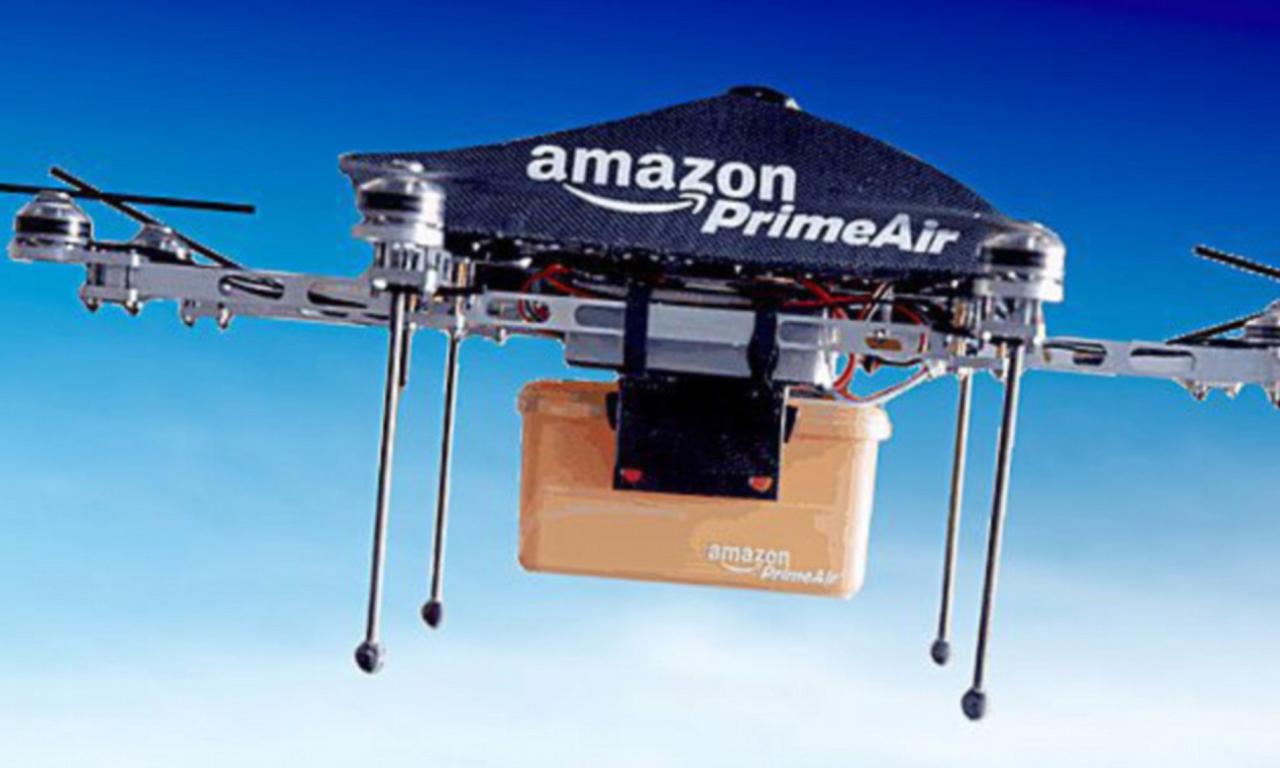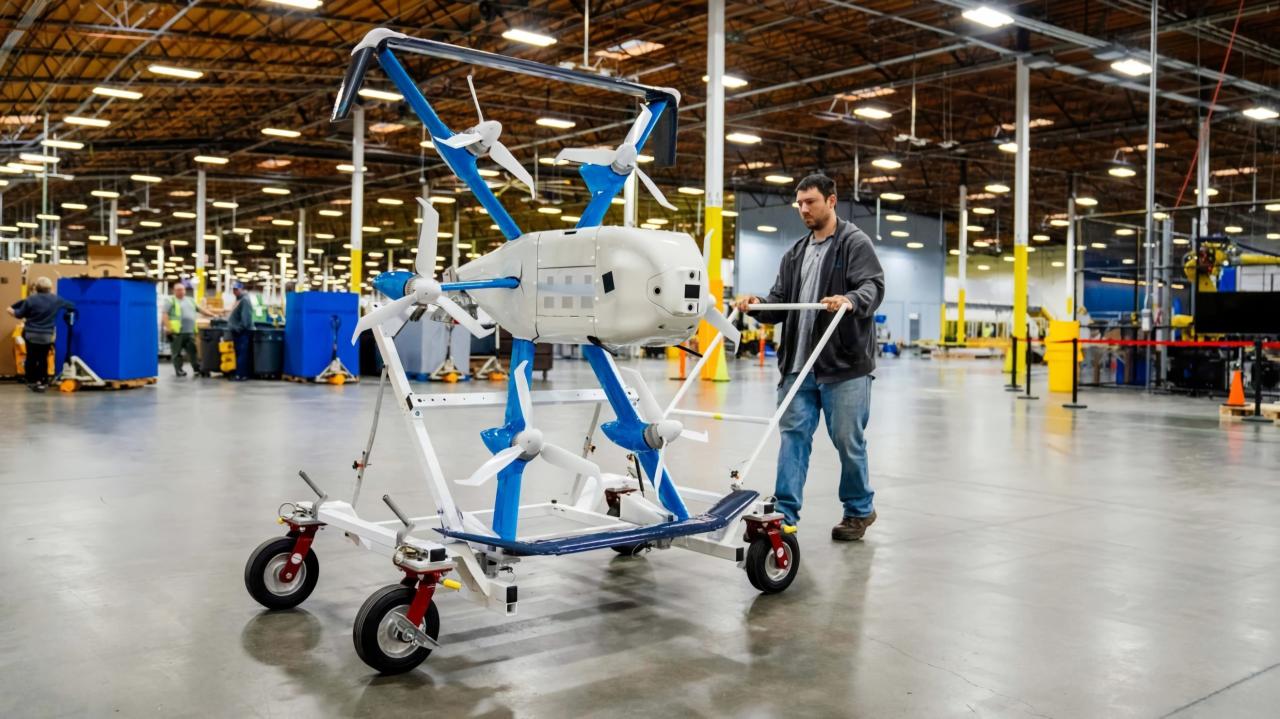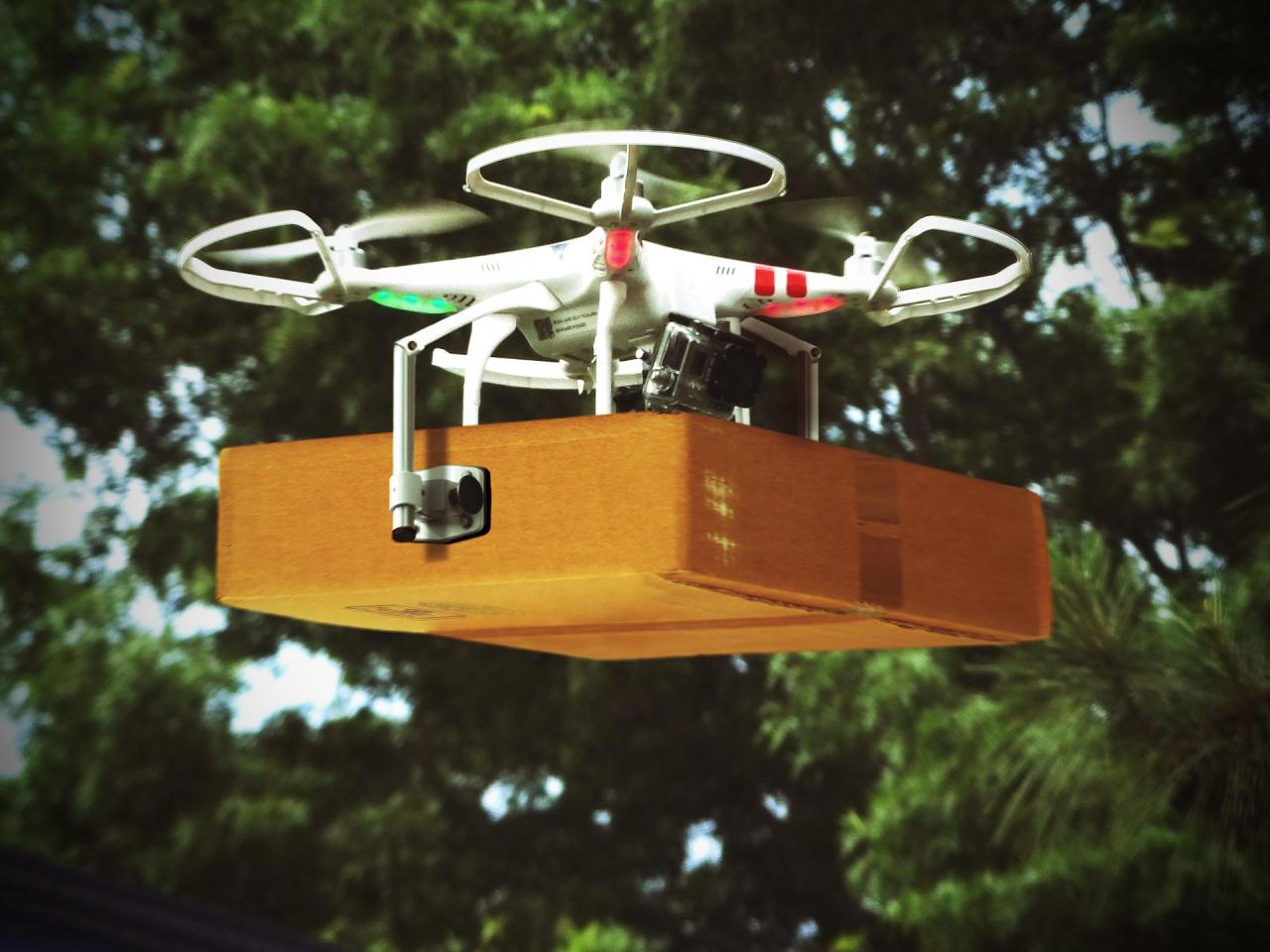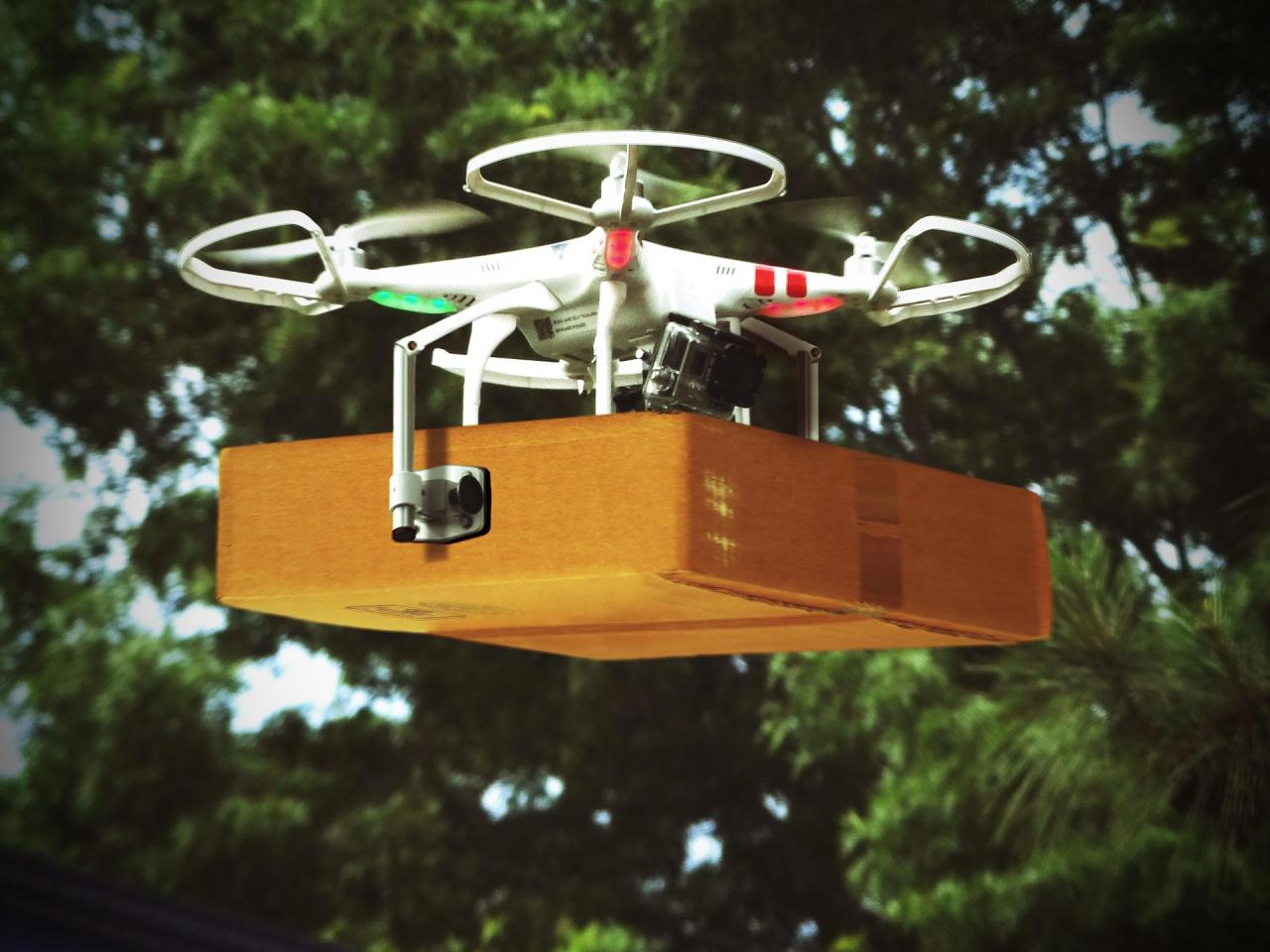Amazon drone delivery locations are rapidly expanding, marking a significant shift in how we receive packages. This exploration delves into the current operational areas, the technology behind the program, and the future implications of this innovative delivery method. We’ll cover everything from the types of drones used and their capabilities to the infrastructure needed to support this ambitious undertaking, including the challenges and successes along the way.
We’ll examine the geographical factors influencing location selection, the types of packages suitable for drone delivery, and Amazon’s plans for future expansion. Understanding the intricacies of Amazon’s drone delivery program provides valuable insight into the evolving landscape of e-commerce logistics and the potential of drone technology.
Current Amazon Drone Delivery Program Status

Amazon’s drone delivery program, officially known as Amazon Prime Air, represents a significant step towards faster and more efficient delivery methods. While still in its relatively early stages of widespread deployment, the program has achieved notable milestones and continues to expand its operational capabilities. This section will provide a comprehensive overview of its current status, geographical reach, and technological underpinnings.Amazon Prime Air’s operational status is characterized by a phased rollout.
It’s not a nationwide service yet, but rather operates in select locations, gradually expanding its reach as technology matures and regulatory approvals are secured. The company focuses on refining its drone technology and logistics infrastructure before widespread deployment.
Amazon Prime Air’s Timeline and Milestones
The development of Amazon Prime Air has been a long-term project, marked by several key milestones. Early testing and development began several years ago, with various prototypes undergoing rigorous testing. The program’s evolution can be seen as a series of incremental improvements in drone technology, software, and regulatory compliance. Significant milestones include successful test deliveries in various locations, securing necessary FAA approvals, and the gradual expansion of operational areas.
While precise dates for all milestones are not publicly available due to competitive reasons, the overall trajectory shows a clear progression towards wider deployment. For example, initial test flights were conducted years ago, leading to more recent fully operational deliveries in specific locations.
Amazon Prime Air’s Drone Technology, Amazon drone delivery locations
Amazon employs a fleet of custom-designed drones for its Prime Air service. These drones are not commercially available off-the-shelf models but rather highly specialized aircraft built to meet Amazon’s specific requirements for autonomous flight, payload capacity, and safety. Key technological specifications include features like advanced obstacle avoidance systems, GPS-guided navigation, and sophisticated flight control algorithms. The drones are designed for vertical takeoff and landing (VTOL), allowing for operation in confined spaces and reducing the need for extensive runways.
Furthermore, they incorporate redundant systems to ensure safety and reliability in case of component failures. Specific details regarding drone models and their exact technical specifications are often kept confidential by Amazon for competitive reasons.
So, you’re curious about where Amazon plans to roll out its drone delivery service? They’re focusing on areas with good infrastructure and relatively low air traffic initially. However, recent news, like this report on a drone crash in Paris , highlights the safety concerns and challenges involved in widespread drone operations. This incident underscores the need for robust safety protocols before Amazon expands its drone delivery locations significantly.
Comparison of Drone Delivery Systems
The following table compares Amazon’s drone delivery system with those of other companies currently involved in similar initiatives. It is important to note that this data is based on publicly available information and may not reflect the most up-to-date specifications for all companies. Technological advancements in this rapidly evolving field lead to frequent updates in drone capabilities.
| Company | Drone Model (Example) | Delivery Range (Approximate) | Package Weight Limits (Approximate) |
|---|---|---|---|
| Amazon | Proprietary Model | 15 miles | 5 lbs |
| Wing (Alphabet) | Various Models | 6-10 miles | 3-5 lbs |
| Zipline | Various Models | Variable, depending on model | Variable, depending on model |
| Drone Delivery Canada | Various Models | Variable, depending on model and payload | Variable, depending on model and payload |
Geographic Locations of Amazon Drone Delivery Operations: Amazon Drone Delivery Locations
Amazon’s drone delivery program, while still in its relatively early stages, operates in a select number of locations across the United States. The strategic choice of these locations reflects a careful consideration of several key factors, balancing operational feasibility with the potential for widespread adoption. These factors are crucial in determining where drone delivery can be most effectively and safely implemented.Amazon’s drone delivery service is currently operational in several locations, but precise details about all operational areas are not publicly available due to competitive and safety reasons.
Publicly available information indicates that operational areas are primarily focused on suburban and rural locations, which present fewer airspace complexities compared to dense urban environments. This focus reflects the company’s phased approach to expanding drone delivery operations.
Current Operational Locations
Currently, Amazon operates its drone delivery service in select areas within the United States. These locations are chosen based on a variety of factors, including airspace availability, population density, and existing infrastructure. Specific city and state details are often kept confidential for operational and competitive reasons. However, publicly available information suggests that operations are centered in areas with lower population density and suitable infrastructure for drone operations.
These areas typically offer less congested airspace and allow for easier management of drone flight paths. Public information focuses on operational regions rather than individual cities.
Factors Influencing Location Selection
Several key factors drive the selection of locations for Amazon’s drone delivery operations. Population density plays a significant role; less densely populated areas offer simpler airspace management and reduced risk of collisions. The existing infrastructure, including reliable internet connectivity for drone control and monitoring, is another critical consideration. A robust and reliable infrastructure ensures smooth operations and minimizes disruptions.
The regulatory environment, including local and federal airspace regulations and permitting processes, also significantly influences location selection. Areas with more streamlined regulatory processes allow for faster deployment and operational efficiency. Finally, the availability of suitable delivery infrastructure, including landing zones and package handling facilities, is also a key determinant.
Challenges and Opportunities Presented by Different Geographical Locations
Different geographical locations present unique challenges and opportunities for drone delivery. Rural areas, for example, often offer less congested airspace but may lack the robust infrastructure found in urban areas. This requires investment in infrastructure development to support drone operations. Urban environments, on the other hand, present the opportunity to reach a larger customer base but face significant challenges related to airspace congestion, building density, and complex regulatory frameworks.
Coastal regions, while offering unique delivery possibilities, might face challenges related to weather conditions and potential interference from maritime activities. Each geographical location necessitates a tailored approach to operational strategies and technological solutions to optimize efficiency and safety.
Infrastructure Requirements for Amazon Drone Delivery
Amazon’s drone delivery program relies on a complex and extensive infrastructure to operate safely and efficiently. This infrastructure goes beyond simply having drones; it requires a network of interconnected systems and facilities to manage the entire delivery process, from takeoff to landing and everything in between. This includes dedicated facilities, sophisticated software, and adherence to strict safety regulations.Getting drones from point A to point B involves much more than just launching them into the air.
Successful drone delivery necessitates a robust, well-planned, and consistently maintained infrastructure. Challenges arise from diverse geographical locations, requiring flexible and adaptable solutions.
Drone Hubs and Charging Stations
Drone hubs serve as central locations for drone operations. These facilities house fleets of drones, charging stations, maintenance areas, and control systems. They are strategically located to optimize delivery routes and minimize travel times. Think of them as mini-airports specifically designed for drones. Larger hubs might handle hundreds of drones simultaneously, requiring substantial space and advanced power infrastructure to support charging and maintenance.
Smaller hubs, on the other hand, might be more localized, serving a smaller geographic area. The design and size of a hub are dependent on the volume of deliveries expected in a particular region. Maintaining these hubs requires regular inspections, software updates, and skilled technicians to handle repairs and maintenance.
Air Traffic Management Systems
Safe and efficient drone operations require sophisticated air traffic management (ATM) systems. These systems track the location and status of all drones in operation, preventing collisions and ensuring compliance with airspace regulations. This involves integrating drone flight paths with existing air traffic control systems, requiring collaboration between Amazon and relevant aviation authorities. The complexity increases exponentially with the number of drones operating simultaneously.
Real-time data analysis, predictive modeling, and automated conflict resolution are crucial elements of a robust ATM system. A failure in the ATM system could lead to accidents, delays, and significant disruptions to the entire delivery network. This is akin to the air traffic control systems used for airplanes, but adapted specifically for the unique characteristics of drone flights.
Amazon’s expanding drone delivery network is reaching more locations, aiming for faster and more efficient shipping. However, the recent mishap, as seen in this report on the orlando drone show accident , highlights the importance of safety regulations and technological advancements in drone operations. These incidents underscore the need for robust safety protocols as Amazon continues to expand its drone delivery locations.
Logistical Challenges in Diverse Geographical Areas
Establishing and maintaining drone delivery infrastructure across diverse geographical areas presents significant logistical challenges. Factors such as terrain, weather conditions, and regulatory environments vary widely. For instance, mountainous regions may require more powerful drones with extended flight ranges, while densely populated urban areas necessitate more sophisticated air traffic management systems to avoid obstacles and ensure safe operation. Remote areas might lack the necessary infrastructure for power and communication, necessitating the development of self-sufficient drone hubs with renewable energy sources and satellite communication capabilities.
Amazon’s expanding drone delivery network is aiming for more locations, but safety is key. Recent incidents, like the one highlighted in this article about the orlando drone show accident , underscore the importance of robust safety protocols. These types of accidents remind us that reliable drone delivery systems require careful planning and stringent regulations to protect both people and property in Amazon’s chosen delivery zones.
Furthermore, regulatory compliance can vary greatly between countries and even within different regions of a single country, adding complexity to the deployment process.
Technological Advancements for Improved Infrastructure
Several technological advancements hold the potential to significantly improve drone delivery infrastructure.
- Advanced Battery Technology: Longer flight times and faster charging capabilities will reduce the need for frequent battery swaps and increase operational efficiency.
- Autonomous Drone Swarms: Coordination of multiple drones working collaboratively will optimize delivery routes and increase overall throughput.
- Improved Sensing and Avoidance Systems: Enhanced obstacle detection and avoidance systems will improve safety and allow for operation in more complex environments.
- Blockchain Technology for Secure Data Management: Blockchain can enhance security and transparency in tracking packages and managing drone operations.
- AI-Powered Predictive Maintenance: Predictive maintenance algorithms can identify potential problems before they occur, reducing downtime and improving operational efficiency.
Regulatory Hurdles and Approvals
Establishing drone delivery infrastructure requires navigating a complex regulatory landscape. Different countries and regions have varying regulations regarding drone operations, airspace usage, and data privacy. Obtaining the necessary permits and approvals can be a time-consuming and challenging process. Amazon needs to work closely with aviation authorities and regulatory bodies to ensure compliance with all applicable laws and regulations.
This includes obtaining licenses for drone operation, airspace access permits, and approvals for data collection and transmission. The regulatory environment is constantly evolving, requiring continuous monitoring and adaptation to ensure ongoing compliance.
Types of Deliveries and Package Restrictions

Amazon’s drone delivery service, while still in its relatively early stages, is designed to handle a specific range of packages. Understanding these limitations is crucial to knowing what can and cannot be delivered via drone. This section will detail the types of packages currently accepted, successful and unsuccessful delivery examples, how weather affects operations, and the safety measures in place.
Currently, Amazon’s drones primarily deliver smaller packages. Think everyday items like books, small electronics, and household goods. There are definite restrictions on size and weight, typically under 5 pounds and within specific dimensional limits to ensure safe and efficient drone transport. Fragile items are generally not suitable for drone delivery due to the inherent risks associated with air transportation.
The contents are largely limited to non-hazardous, non-perishable goods.
Package Size and Weight Limits
The maximum weight limit for a package delivered via Amazon’s drone is currently around 5 pounds. Exceeding this weight can compromise the drone’s stability and flight capabilities, increasing the risk of accidents. Similarly, there are dimensional restrictions; packages must fit within a specific size envelope to ensure they can be securely attached to the drone and transported without causing imbalance.
Packages that are too large or irregularly shaped are unsuitable for drone delivery.
Examples of Successful and Unsuccessful Deliveries
A successful delivery might involve a small package containing a book or a pair of headphones, delivered swiftly and safely to a customer’s backyard. The drone accurately navigates to the designated location, autonomously lands, releases the package, and returns to its base. Conversely, an unsuccessful delivery could be due to a package exceeding the weight or size limits, resulting in the drone being unable to lift off or maintain stability.
Another reason might be an unforeseen obstacle at the delivery location, such as a large animal or unexpected obstruction, preventing a safe landing.
Drone Delivery System’s Response to Weather Conditions
Amazon’s drone delivery system incorporates sophisticated weather monitoring and decision-making capabilities. In adverse weather conditions like heavy rain, strong winds, or low visibility, the drone’s flight is automatically aborted. The system continuously monitors real-time weather data and adjusts delivery schedules accordingly. This prioritizes safety and prevents accidents caused by challenging weather situations. For instance, a planned delivery might be postponed until weather conditions improve, ensuring both the safety of the drone and the integrity of the package.
Safety Protocols and Procedures
Amazon employs numerous safety protocols to mitigate risks associated with drone delivery. These include redundant systems to ensure flight stability, collision avoidance technology, and geo-fencing to restrict flight paths to designated areas. The drones themselves are designed with multiple safety features, including fail-safe mechanisms that can take over in case of malfunctions. Regular maintenance and rigorous testing are also part of the process to maintain the drones’ operational readiness and ensure the safety of both the drone and the delivered package.
Future Expansion Plans for Amazon Drone Delivery
Amazon’s drone delivery program, while still in its relatively early stages, shows significant potential for expansion. The company is actively working to increase its operational reach, improve its technology, and address the various challenges associated with widespread drone delivery. This expansion will be driven by technological advancements, evolving regulations, and a growing demand for faster and more efficient delivery options.
Projected Expansion Timeline and Target Locations
Amazon’s expansion plans are ambitious, aiming for a substantial increase in both geographic coverage and delivery volume. While precise timelines remain confidential, the company’s public statements and observed operational growth suggest a phased approach. Initial expansion will likely focus on areas with existing infrastructure and favorable regulatory environments, such as suburban and rural communities with less dense airspace.
Larger metropolitan areas will likely be targeted later, as technological advancements allow for safer and more efficient navigation in complex airspace. Specific locations are difficult to predict with certainty, but regions with high population density and a strong e-commerce presence are likely candidates for prioritized expansion. For example, areas with existing fulfillment centers and strong customer bases in the United States and possibly expanding internationally to regions with similar infrastructure and regulatory frameworks, such as parts of Europe or Canada, could be prioritized.
Technological Advancements and Their Impact
Technological advancements are crucial to Amazon’s drone delivery expansion. Improvements in battery technology, for example, will extend flight range and payload capacity, enabling drones to reach more remote locations and deliver larger packages. Advances in autonomous navigation and obstacle avoidance systems will enhance safety and reliability, especially in more complex environments. The integration of artificial intelligence (AI) for improved route planning and traffic management will optimize delivery efficiency.
Furthermore, the development of drone-specific air traffic management systems will be essential for safe and efficient integration of drones into existing airspace. For example, the development of beyond visual line of sight (BVLOS) technology will enable drones to fly farther and more autonomously, significantly expanding the range of possible delivery areas.
Environmental and Social Impacts of Scaling Up Drone Delivery
Scaling up Amazon’s drone delivery operations will have both environmental and social impacts. While drones offer potential environmental benefits by reducing reliance on ground transportation and its associated carbon emissions, the environmental impact depends heavily on the energy source used to power the drones. The use of electric-powered drones is crucial to minimize the environmental footprint. However, the manufacturing and disposal of drones and batteries need to be considered.
Socially, job displacement in traditional delivery services is a concern, but new opportunities may emerge in drone maintenance, operation, and related fields. Addressing these potential negative impacts through responsible development and workforce retraining initiatives will be essential for ensuring the positive social acceptance of this technology. For instance, initiatives like partnerships with local communities to create drone-related jobs can help to mitigate negative social impacts.
Potential Future Features of Amazon Drone Delivery
The following table Artikels some potential future features of Amazon’s drone delivery program:
| Feature | Timeline | Benefits | Challenges |
|---|---|---|---|
| Increased Delivery Speed (e.g., sub-30 minute delivery) | 2025-2030 | Enhanced customer satisfaction, increased competitiveness | Technological advancements needed in battery technology and autonomous navigation; regulatory hurdles |
| Expanded Package Types (e.g., heavier packages, temperature-sensitive goods) | 2026-2035 | Increased delivery versatility, broader range of products available for drone delivery | Development of drones with increased payload capacity and advanced climate control systems |
| Nighttime Delivery | 2028-2035 | Extended delivery window, increased efficiency | Technological advancements in autonomous navigation and lighting systems; regulatory approval for nighttime flights |
| Automated Package Handling and Sorting at Delivery Locations | 2027-2032 | Improved efficiency, reduced delivery times | Integration with existing infrastructure and development of reliable automated systems |
Conclusive Thoughts

Amazon’s drone delivery program represents a bold step into the future of logistics, offering a glimpse into a world of faster, more efficient delivery. While challenges remain in terms of infrastructure, regulation, and technological advancements, the potential benefits – from reduced delivery times to minimized environmental impact – are undeniable. As the program expands, we can expect to see significant changes in how we receive our online orders, transforming the landscape of e-commerce as we know it.
Popular Questions
What types of packages can’t be delivered by Amazon drones?
Generally, oversized, heavy, fragile, or temperature-sensitive items are unsuitable for drone delivery due to size and safety limitations.
How does Amazon ensure the security of packages during drone delivery?
Amazon employs various security measures, including encrypted communication, GPS tracking, and potentially tamper-evident packaging to ensure package security throughout the delivery process.
What are the environmental benefits of Amazon drone delivery?
Drone delivery can potentially reduce carbon emissions associated with ground transportation, particularly for short-distance deliveries. However, the overall environmental impact depends on factors like drone energy sources and manufacturing processes.
What happens if a drone encounters bad weather during a delivery?
Amazon’s drones are equipped with sophisticated sensors and software to detect and avoid bad weather. In severe conditions, deliveries are typically delayed or rerouted.
